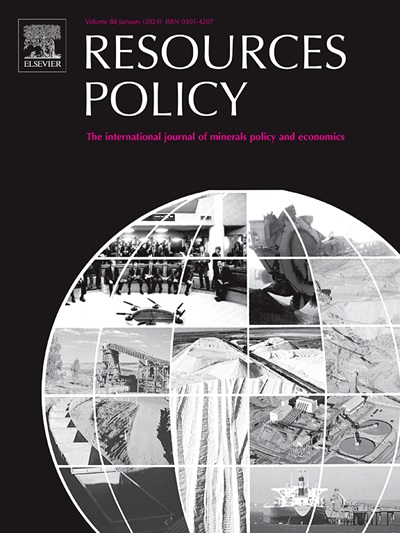基于价格模式组合的锂离子电池产业链安全与稳定预测模型
IF 10.2
2区 经济学
0 ENVIRONMENTAL STUDIES
引用次数: 0
摘要
价格是产业链中至关重要的市场信号,价格的平稳传递对整个产业链的安全性和稳定性具有重要影响。本文将锂离子电池产业链视为一个复杂系统,以价格为模态信号,构建了 FEEMD-NAR-HMM 产业链安全与稳定性预测模型。研究结论如下:(1)锂电产业链呈现典型的 "价格-稳定性 "耗散结构,产业链内部价格波动的一致性对其整体安全性和稳定性具有重要影响。(2)当锂电产业链不同阶段的产品同时出现价格上涨或下跌时,产业链的安全性和稳定性处于较高水平。当锂电产业链不同阶段价格波动的传导平滑度较低时,产业链的安全性和稳定性处于较低水平。(3)短期内,锂电产业链仍将面临波动风险。政府应实施宏观调控措施,稳定锂电市场,加大锂资源循环利用的研究投入,防止出现锂资源短缺危机。本文章由计算机程序翻译,如有差异,请以英文原文为准。
A predictive model for the security and stability of the lithium-ion battery industry chain based on price modal combinations
Prices act as crucial market signals within industrial chains, and the smooth transmission of prices has significantly impacts on the safety and stability of the entire chain. This paper considers the lithium-ion battery industry chain as a complex system and uses prices as modal signals to construct an FEEMD-NAR-HMM industrial chain safety and stability prediction model. The research findings are as follows: (1) The lithium-ion industry chain exhibits a typical "price-stability" dissipative structure, where the consistency of price fluctuations within the industry chain has a significant impact on its overall safety and stability. (2) When products at different stages of the lithium-ion industry chain experience simultaneous price increases or decreases, the safety and stability of the industry chain are at a high level. When the transmission smoothness of price fluctuations across different stages of the lithium-ion industry chain is low, the safety and stability of the industry chain are at a low level. (3) In the near future, the lithium-ion industry chain will continue to exposed to volatility risks. The government should implement macroeconomic control measures to stabilize the lithium-ion market and increase research investment in lithium resource recycling to prevent a crisis of lithium resource shortages.
求助全文
通过发布文献求助,成功后即可免费获取论文全文。
去求助
来源期刊

Resources Policy
ENVIRONMENTAL STUDIES-
CiteScore
13.40
自引率
23.50%
发文量
602
审稿时长
69 days
期刊介绍:
Resources Policy is an international journal focused on the economics and policy aspects of mineral and fossil fuel extraction, production, and utilization. It targets individuals in academia, government, and industry. The journal seeks original research submissions analyzing public policy, economics, social science, geography, and finance in the fields of mining, non-fuel minerals, energy minerals, fossil fuels, and metals. Mineral economics topics covered include mineral market analysis, price analysis, project evaluation, mining and sustainable development, mineral resource rents, resource curse, mineral wealth and corruption, mineral taxation and regulation, strategic minerals and their supply, and the impact of mineral development on local communities and indigenous populations. The journal specifically excludes papers with agriculture, forestry, or fisheries as their primary focus.
 求助内容:
求助内容: 应助结果提醒方式:
应助结果提醒方式:


